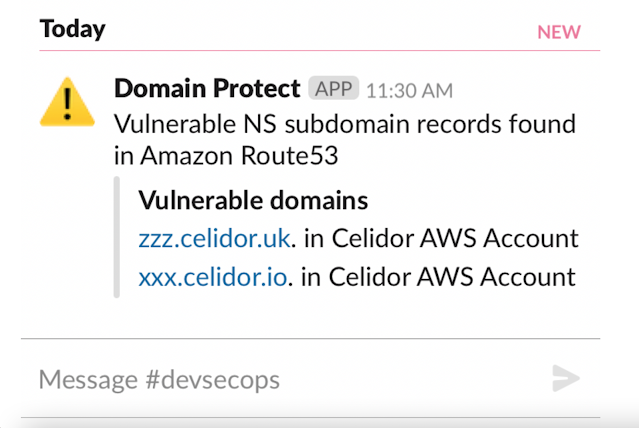Domain-Protect – Protect Against Subdomain Takeover
Protect Against Subdomain Takeover
- scans Amazon Route53 across an AWS Organization for domain records vulnerable to takeover
- vulnerable domains in Google Cloud DNS can be detected by Domain Protect for GCP
deploy to security audit account
scan your entire AWS Organization
receive alerts by Slack or email
or manually scan from your laptop
subdomain detection functionality
Scans Amazon Route53 to identify:
- Alias records for CloudFront distributions with missing S3 origin
- CNAME records for CloudFront distributions with missing S3 origin
- ElasticBeanstalk Alias records vulnerable to takeover
- ElasticBeanstalk CNAMES vulnerable to takeover
- Registered domains with missing hosted zones
- Subdomain NS delegations vulnerable to takeover
- S3 Alias records vulnerable to takeover
- S3 CNAMES vulnerable to takeover
- Vulnerable CNAME records for Azure resources
- CNAME records for missing Google Cloud Storage buckets
optional additional check
Turned off by default as it may result in Lambda timeouts for large organisations
- A records for missing storage buckets, e.g. Google Cloud Load Balancer with missing backend storage
To enable, create this Terraform variable in your tfvars file or CI/CD pipeline:
lambdas = ["alias-cloudfront-s3", "alias-eb", "alias-s3", "cname-cloudfront-s3", "cname-eb", "cname-s3", "ns-domain", "ns-subdomain", "cname-azure", "cname-google", "a-storage"]
options
- scheduled lambda functions with email and Slack alerts, across an AWS Organization, deployed using Terraform
- manual scans run from your laptop or CloudShell, in a single AWS account
notifications
- Slack channel notification per vulnerability type, listing account names and vulnerable domains
- Email notification in JSON format with account names, account IDs and vulnerable domains by subscribing to SNS topic
requirements
- Security audit account within AWS Organizations
- Security audit read-only role with an identical name in every AWS account of the Organization
- Storage bucket for Terraform state file
- Terraform 1.0.x
usage
- replace the Terraform state S3 bucket fields in the command below as appropriate
- for local testing, duplicate terraform.tfvars.example, rename without the .example suffix
- enter details appropriate to your organization and save
- alternatively enter Terraform variables within your CI/CD pipeline
terraform init -backend-config=bucket=TERRAFORM_STATE_BUCKET -backend-config=key=TERRAFORM_STATE_KEY -backend-config=region=TERRAFORM_STATE_REGION
terraform workspace new dev
terraform plan
terraform apply
AWS IAM policies
For least privilege access control, example AWS IAM policies are provided:
- domain-protect audit policy – attach to domain-protect audit role in every AWS account
- domain-protect audit trust relationship for domain-protect audit role in every AWS account
- domain-protect audit trust relationship with External ID for domain-protect audit role in every AWS account
- domain-protect deploy policy – attach to IAM group or role assumed by CI/CD pipeline
adding new checks
- create a new subdirectory within the terraform-modules/lambda/code directory
- add Python code file with same name as the subdirectory
- add the name of the file without extension to
var.lambdasin variables.tf - add a subdirectory within the terraform-modules/lambda/build directory, following the existing naming pattern
- add a .gitkeep file into the new directory
- update the .gitignore file following the pattern of existing directories
- apply Terraform
adding notifications to extra Slack channels
- add an extra channel to your slack_channels variable list
- add an extra webhook URL or repeat the same webhook URL to your slack_webhook_urls variable list
- apply Terraform
testing
- use multiple Terraform workspace environments, e.g. dev, prd
- use the
slack_channels_devvariable for your dev environment to notify a test Slack channel - for new subdomain takeover categories, create correctly configured and vulnerable domain names in Route53
- minimise the risk of malicious takeover by using a test domain, with domain names which are hard to enumerate
- remove any vulnerable domains as soon as possible
ci/cd
- infrastructure has been deployed using CircleCI
- environment variables to be entered in CircleCI project settings:
| ENVIRONMENT VARIABLE | EXAMPLE VALUE / COMMENT |
|---|---|
| AWS_ACCESS_KEY_ID | using domain-protect deploy policy |
| AWS_SECRET_ACCESS_KEY | – |
| TERRAFORM_STATE_BUCKET | tfstate48903 |
| TERRAFORM_STATE_KEY | domain-protect |
| TERRAFORM_STATE_REGION | us-east-1 |
| TF_VAR_org_primary_account | 012345678901 |
| TF_VAR_security_audit_role_name | not needed if “domain-protect-audit” used |
| TF_VAR_external_id | only required if External ID is configured |
| TF_VAR_slack_channels | [“security-alerts”] |
| TF_VAR_slack_channels_dev | [“security-alerts-dev”] |
| TF_VAR_slack_webhook_urls | [“https://hooks.slack.com/services/XXX/XXX/XXX“] |
- to validate an updated CircleCI configuration:
docker run -v `pwd`:/whatever circleci/circleci-cli circleci config validate /whatever/.circleci/config.yml
limitations
- this tool cannot guarantee 100% protection against subdomain takeover
- it currently only scans Amazon Route53, and only checks a limited number of takeover types
- vulnerable domains in Google Cloud DNS can be detected by Domain Protect for GCP









